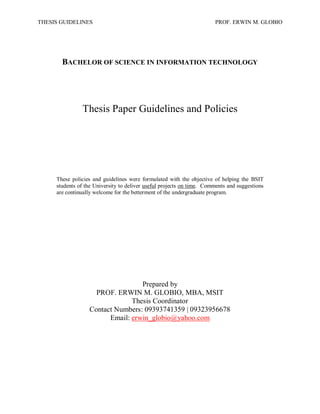This document outlines the thesis guidelines and policies set by Prof. Erwin M. Globio for Bachelor of Science in Information Technology students. The guidelines provide information on the stages of the thesis project, including preliminary and final proposal writing as well as the final defense. It describes the roles and responsibilities of the project proponent, adviser, defense panel, and thesis coordinator. Finally, it specifies the formatting and content requirements for the thesis proposal and final paper, as well as related documentation.















![THESIS GUIDELINES PROF. ERWIN M. GLOBIO
Page 16
A review of a book, film, television program, etc.
Baumeister, R. F. (1993). Exposing the self-knowledge myth [Review of the book The self-knower: A
hero under control]. Contemporary Psychology, 38, 466-467.
An entry in an encyclopedia
Bergmann, P. G. (1993). Relativity. In The new encyclopedia britannica (Vol. 26, pp. 501-508). Chicago:
Encyclopedia Britannica.
5.3.5.3 Part of a non-periodical (such as a book chapter or an article in a collection)
Author, A. A., & Author, B. B. (Year of Publication). Title of chapter. In A. Editor & B. Editor (Eds.),
Title of book (pages of chapter). Location: Publisher.
N.B. When you list the pages of the chapter or essay in parentheses after the book title, use "pp." before
the numbers: (pp. 1-21). This abbreviation, however, does not appear before the page numbers in
periodical references.
Example:
An article or chapter of a book
O'Neil, J. M., & Egan, J. (1992). Men's and women's gender role journeys: Metaphor for healing,
transition, and transformation. In B. R. Wainrib (Ed.), Gender issues across the life cycle (pp.
107-123). New York: Springer.
5.3.6 Basic Forms for Electronic Sources
5.3.6.1 A web page
Author, A. A. (Date of Publication or Revision). Title of full work [online]. Available: full web address.
(Date of access).
N.B. "Date of access" should indicate the date you visited the website. This is important because online
information is frequently altered.
Example:
Daly, B. (1997). Writing argumentative essays. [online]. Available:
http://www.eslplanet.com/teachertools/argueweb/frntpage.htm. (May 12, 1998)
5.3.6.2 An online journal or magazine
Author, A. A., & Author, B. B. (Date of Publication). Title of article. In Title of full work [online].
Available: full web address (Date of access).
Example:
Kenneth, I. (1995). A Buddhist response to the nature of human rights. [9 pars.] Journal of Buddhist
Ethics [online serial], 2. Available: http://www.cac.psu.edu/jbe/twocont.html. (June 15, 1998)](https://image.slidesharecdn.com/thesisguidelines-140328091917-phpapp01/85/BSCS-BSIT-Thesis-Guidelines-16-320.jpg)



![THESIS GUIDELINES PROF. ERWIN M. GLOBIO
Page 20
6. Forms
6.1 Title Page
<Title of Project Paper>
A Project Paper [Proposal]
Presented to the
Faculty of the Information Technology Education
Department of Information Technology
Far Eastern University - Manila
In Partial Fulfilment
of the Requirements for the Degree of
<Program Name>
Bachelor of Science in Information Technology
by
<lastname, firstname, middle initial of proponents>
<adviser‟s signature>
<adviser‟s name>
Faculty Adviser
<date of submission>](https://image.slidesharecdn.com/thesisguidelines-140328091917-phpapp01/85/BSCS-BSIT-Thesis-Guidelines-20-320.jpg)


![Page 23
6.4 Final Project Paper Defense Evaluation Sheet
The evaluation sheet is given by the thesis coordinator to the panel before the defense.
INSTITUTE OF ARTS AND SCIENCES
BACHELOR OF SCIENCE IN APPLIED MATHEMATICS
FINAL PROJECT PAPER DEFENSE
EVALUATION SHEET
Project Paper Title: Proponent:
Contact No. Deadline of Revision
Adviser
for acceptance
for approval
Venue Date
Panel Members Signature
Recommendations: [ ] Accept with Revisions [ ] Not Accepted
Revisions Page # on the
revised
document
The proponent must indicate the page # in the appropriate column in which the revisions can be found in
the revised document.
Actions on the evaluation sheet:
1. Revisions will be listed by the lead panel upon presentation of verdict to the proponent.
2. Evaluation sheet will be forwarded to the department secretary and a photocopy will be given to the
proponent.
3. The proponent shall indicate on the “page #” column the page number in which the panel members
can locate the actual revision during final approval.](https://image.slidesharecdn.com/thesisguidelines-140328091917-phpapp01/85/BSCS-BSIT-Thesis-Guidelines-23-320.jpg)
![THESIS GUIDELINES PROF. ERWIN M. GLOBIO
Page 24
6.5 Final Project Paper Defense Approval Form
The approval form is attached as the cover page of a revised project paper document for approval. This
form is secured from the thesis coordinator after the defense.
INSTITUTE OF TECHNOLOGY
BACHELOR OF SCIENCE IN INFORMATION TECHNOLOGY
FINAL PROJECT PAPER DEFENSE
APPROVAL SHEET
Final Project Paper Title: Proponent:
Contact No. Defended Submitted
Adviser
for acceptance
for approval
Accepted/Approved
Signature Date Remarks
Panel Members
Checked Approved
Signature Date Signature Date
Recommendation of Lead Panel:[ ] Accepted [ ] Revise and recheck by all panel members
[ ] Revise and recheck by (please specify)
Revisions Page # on the
revised
document
This serves as the cover page of the revised document.
Adviser must approve the revisions before its presentation to the panel. Otherwise panel members
must not accept the revisions unless otherwise indicated in the revision sheet.
Panel members sign either in the checked column indicating it has been checked or the approved
indicating final approval.
The lead panel is the last to sign and give the final recommendation.
Actions on the approval form:
1. Project Paper adviser must approve the revisions before the revised document is passed to the panel
members;
2. Panel members shall evaluate whether required revisions were complied, if not, additional revisions
may be required;
3. The lead panel shall be the last to evaluate and give the final recommendation;
4. If the recommendation is to revise further the document, the proponent shall indicate on the “page #”
column the page number in which the panel members can locate the actual revisions during final
approval and another iteration of approval will be made.](https://image.slidesharecdn.com/thesisguidelines-140328091917-phpapp01/85/BSCS-BSIT-Thesis-Guidelines-24-320.jpg)
